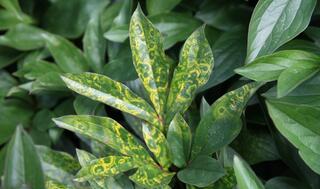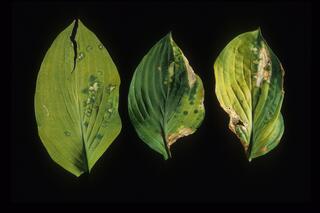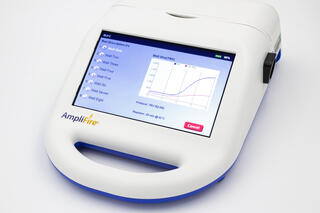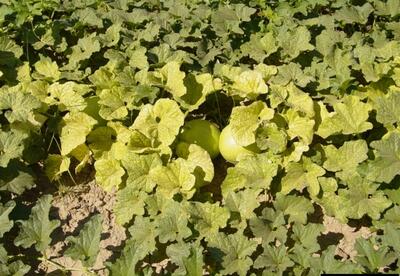
Figure 1: TRV symptoms on potato tuber
--- FOR IMMEDIATE RELEASE ---
Agdia, Inc. (Elkhart, IN) has commercialized a rapid and user-friendly, RNA-based assay, on their AmplifyRP® XRT platform, for the detection and identification of Tobacco rattle virus (TRV).
Tobacco rattle virus (Tobravirus) is globally distributed and has a wide, ever-expanding host range, infecting more than 400 species of ornamentals, vegetable crops and weedy plants. This virus causes severe disease on potato, Solanum tuberosum, known as corky ringspot or spraing. Symptoms of this disease vary according to variety and environmental conditions. Foliar symptoms are rare, but when present include leaf stunting, distortion and mottling. Symptoms on tubers are typical and include corky, necrotic arcs, rings or flecks that form on and within the flesh of the tubers (Figure 1.). Corky ringspot disease is potentially devastating to potato production as symptomology renders tubers unmarketable for chip production and fresh markets. Tuber necrosis symptoms of TRV are often confused with those caused by Potato mop-top virus (PMTV, Pomovirus), whereas ringspot symptoms on tuber skin are mistaken for Potato virus Y (PVY, Potyvirus) infections.

Tobacco rattle virus infects several species of herbaceous perennials, causing potentially severe disease in some species. Ornamental hosts include Astilbe, Dicentra, Epimedium, Gladiolus, Heuchera, Hosta, Hyacinthus, Paeonia, Narcissus, Tagetes, Tulipa and Vinca. Symptomology varies according to host, and many are latently infected, with the virus proliferating in the root system. Nevertheless, TRV infections can express as angular, yellow-white line patterns and ringspots on the foliage of Paeonia spp. (Figure 2, courtesy of Gary A. Chastagner.) and mottling, mosaic and necrosis on Hosta foliage (Figure 3.). Foliar symptoms can reduce the aesthetic value of ornamentals; however, it is unclear how TRV infections affect the overall vigor of asymptomatic hosts. Additional economically important host genera include Allium, several in Brassicaceae, Capsicum, Cucumis and Phaseolus.
This virus is transmitted locally through the feeding habits of stubby root nematodes in the Trichodorus and Paratrichodorus genera. These nematodes are migratory ectoparasites, feeding externally and moving from plant to plant. Tobacco rattle virus can be transmitted by adults and juveniles, and their trophic behavior facilitates dissemination. Moreover, stubby root nematodes will feed on many common weedy species, including Stellaria media and Solanum nigrum, producing inoculum reservoirs in the absence of cultivated hosts. The movement of nematodes within a field is limited; however, infested soil can be moved between fields on contaminated tools and equipment. While mechanical transmission through infected sap does occur, its importance on the epidemiology of TRV is not highly characterized.

The long-distance dispersal of TRV is via the interstate shipment of infected plant parts. The ornamental market in the U.S. does not typically test for the presence of TRV. Due to this, a comprehensive list of ornamental hosts is not available, and many latently infected plants are shipped throughout the country. Potatoes are traded on international markets and are required to be tested for TRV before exportation can occur. Moreover, potato germplasm is tested once importation has taken place.
Plant-pathogenic viruses have several general components in common, including the presence of a coat protein. The coat protein functions as a protective covering for the fragile genetic material it envelops. Moreover, the coat protein is a common target for serological diagnostic tests such as ELISA and the ImmunoStrip®, both of which rely on the presence and novelty of these gene products. Tobacco rattle virus has strains known to lack a coat protein while being able to infect hosts and cause disease. Therefore, traditional serological diagnostic tests are unreliable for detection of this virus, and a molecular diagnostic product is required.
Agdia’s new AmplifyRP® XRT assay is based on recombinase polymerase amplification (RPA). This technology promotes the rapid amplification and detection of nucleic acid targets, DNA or RNA, while maintaining a single operating temperature of 39 – 42 oC. The AmplifyRP® XRT products achieve target sensitivity and specificity comparable to PCR, while having clear advantages over the lab-based technology. AmplifyRP® XRT products do not require a nucleic acid purification step; crude sample extracts are prepared using a simple extraction buffer and tested directly. This makes the testing process simple and saves the end-user valuable time. When paired with Agdia’s AmpliFire® isothermal fluorometer, the XRT system is a rapid, user-friendly tool that can be implemented in the field or the lab by personnel with limited experience in molecular diagnostics (Figure 4.).

Agdia states their new assay was tested against an extensive collection of confirmed TRV isolates from numerous ornamental hosts, potato and additional vegetable hosts, providing 100% accuracy for detection of true positives. Moreover, no cross-reactivity was observed with a comprehensive panel of pathogens, including Barley stripe mosaic virus, Beet soil-borne virus, Cucumber green mottle mosaic virus, Kyuri green mottle mosaic virus, Odontoglossum ringspot virus, Pea early browning virus, Pepper ringspot virus, Potato mop-top virus, Ribgrass mosaic virus, Soil-borne wheat mosaic virus, Tobacco mild green mosaic virus, Tobacco mosaic virus-c and Tomato mosaic virus.
Sensitivity for this assay is comparable to that observed with the published conventional and qPCR to which it was compared. This product includes an endogenous RNA control and was developed to test leaf and sprout tissue. Moreover, Agdia validated this product for testing tuber tissue directly. For more information on Agdia’s complete line of AmplifyRP® assays, please visit Agdia’s website www.agdia.com.
About Agdia
A leading provider of diagnostic solutions for agriculture, Agdia, Inc. has been serving plant breeders, propagators, growers, universities, regulatory organizations and private testing laboratories since 1981. The company offers a comprehensive portfolio of validated, easy-to-use diagnostics for identifying plant pathogens, plant hormones, and transgenic traits. Moreover, Agdia operates an ISO accredited, in-house, testing services laboratory. Agdia’s quality management system is ISO 9001:2015 certified and their Testing Services Laboratory is ISO 17025:2017 accredited. Visit the company’s website at www.agdia.com, e-mail info@agdia.com, phone 1-574-264-2615 (toll-free 800-622-4342) or fax 1-574-264-2153.
“This material is based upon work that is supported by the National Institute of Food and Agriculture, U.S. Department of Agriculture Small Business Innovation Research (SBIR) Program, under award number 2018-33610-28545 and the Indiana Economic Development Corporation (IEDC). Any opinions, findings, conclusions, or recommendations expressed in this publication are those of the author(s) and do not necessarily reflect the view of the U.S. Department of Agriculture.”
Use of any images in this article does not constitute endorsement of any product by the image provider.
###





